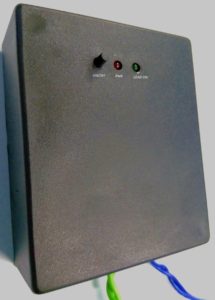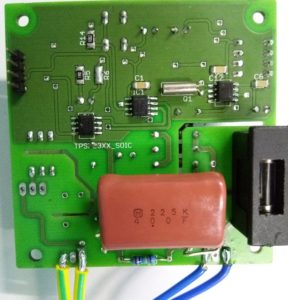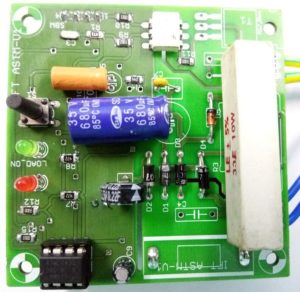
Project Code : ARTSW/G2230
Components used : Mainly TI’s MSP430G2230, TPS7333QDR, BQ32000
Supply Source: Mains AC 220 VAC 50- 60 Hz, 1ɸ
Click here to see how this device has been installed to control a Pump motor.
Basic Operation : This device is very unique and has a plethora of applications to be found with. The device basically replaces the pain of regularly or daily switching ON/ OFF of devices (any kind, be it a Lamp or a Glow-signboard or even Water Pump Motor) at a specific time (really specific) time in a day. These devices can be of two types. One type takes control of the load once in a day. That is switches on and off the device, just once everyday, and an advanced version that switches on/off the load once at a programmable time in a complete calendar year. Details are to be provided in the item datasheet.

This device mainly operates from the mains power, which means you don’t have to use any other power adapter with this device. It will consume utmost lowest power for its operation. The maximum operational ratings are specified in the technical datasheet. The power input is also used to charge the battery inside the device that keeps track of the time keeping function and hence we claim this to be a completely maintenance free, hassle free device. You fix it, and just program it once. There is no need to worry about the calibration, or troubleshooting.
To program the device, there is only one button in the front facial position (shown in picture) ON/OFF switch. To set the start or ON time, just press the switch once and the green LED (marked as LOAD ON) will glow to show that the connected device has been switched ON. This time will be saved as a snapshot inside the unit into the connected EEPROM, so that even if the device is switched OFF, the switch on time is not erased. Again, when planning to set the switch off time, just press the button again (wherein the green LED will turn OFF) which will switch OFF the connected device and this OFF time will be similarly saved inside the EEPROM.
One more important point thing to consider is setting the internal RTC. This device runs on Texas Instruments’ RTC IC BQ32000 which runs from a 32.768 KHz crystal and is backed by Super capacitor to avoid changing of battery. When the project or the device is newly purchased, press and hold the push button switch for approximately 5 to 7 seconds, untill you see the green LED glow steady (REMEMBER NOT TO PERFORM THIS OPERATION WITH THE LOAD/ DEVICE CONNECTED). This will synchronize the internal RTC with the natural clock once and for all. Thereafter, just switch off the device (meaning disconnect the unit entirely from power) and connect it back to power again. This makes the unit fully ready for operation.
Changing of the ON / OFF times is easy because repeated pressings of the switch will overwrite old ON and OFF times. But it is impossible to retrieve the overwritten ON / OFF time. So if you have mistakenly pressed the ON/OFF button, it has most probably overwritten the preset Switch ON time.
What you can get for free :
- Technical Datasheet (Click Here for PDF datasheet)
- Schematic Diagram in Eagle .sch file (click here)
Price for ONE PROJECT: INR 500 (will include all detailed design files, one PCB with only the MCU populated on it and pre-programmed and locked).If you have purchased it, you can download the files here. However, this rar file is password protected and you will receive the password in your email along with your purchase invoice.
Price for ONE COMPLETE DEVICE (as shown in picture above): INR 1200 (with 1 year replacement warranty only inside INDIA). If you have purchased it, you can download the files here. However, this rar file is password protected and you will receive the password in your email along with your purchase invoice. The complete device will be shipped to you and the details of tracking numbers will be notified to you once you once we have received the payment.
Price for ONE COMPLETE DEVICE (as shown in picture above INTERNATIONAL ORDERS): US $ 16.99 / £ 12.99 / € 15.55 (Shipping extra and will be intimated through email. If you wish to buy, please email me at turjasu@turjasuzworld.in )
Required Software to be used for the project:
Code Composer Studio (Direct Download from TI website, since the projects have been compiled and made in CCS v6.1.1 workspace, I recommend you NOT to use the later versions of CCS. This is because the later versions might have compilers that will not be able to fit the code inside the tiny flash of MSP430G2230. So stick to the one I have given the link to! Linux Users, click here.
More Photos (internal circuitry):


Sir, I want to understand if this project can be done using other microcontrollers as well ?
Yes you can. Definitely, rather you can try out smaller 8 bit MCUs like ATTiny or PIC. And instead of the RTC used here you may use general RTCs like DS1307. In such 5 volt operable chips, you do not need the 3.3 V LDO. But you cannot use the schematic and the libraries given here. In such case you might want to develop your own libraries. Here I2C has been established using USI and not USCI, in conventional chips, you can use more simpler bit banging methods.
However, the power section must be recalculated to supply the current your MCU and system requires.
It is very low price but very useful device. I used this device around 1 year and it is still running successfully. Thanks for such a device like this.
Thank you mam. Your acknowledgement shall be highly beneficial to us!
Can this device be used at ATM for timing control of ACs ?
Yes. You can program the AC timinhs separately abd it will automatically switchover from one AC to another